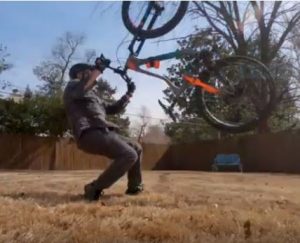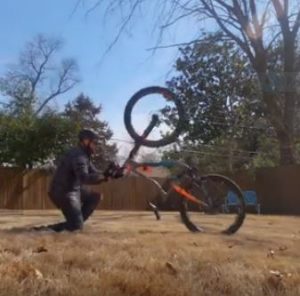
- Что такое мануал
- Подготовка к обучению
- Обучение технике мануала
- Серф
- Советы
- Итоги
Что такое мануал

Одна из разновидностей мануала – ноуз мануал (nose manual). В данном случае балансирование происходит на переднем колесе велосипеда.
Также одна из разновидностей – серф (surf). Это облегченный вариант выполнения элемента. Выполняется точно также как manual, но с использованием заднего тормоза, что помогает в удерживании баланса. Часто путают с мануалом.
Manual не является чем-то базовым для обучения других трюков. Это отдельный самостоятельный элемент из разряда «артистической езды». Более критичен только в дисциплинах по типу слалом, BMX race, 4x. Для остальных дисциплин этот трюк больше интересен с точки зрения красоты и общего навыка владения велосипедом.
Подготовка к обучению

- В роли тренировочного велосипеда подойдет любой имеющийся у вас во владении вариант. Но если есть выбор, то желательно остановиться на хардтейле, а ещё лучше на низком хардтейле – BMX, дерт, стрит байке. Такими велосипедами проще управлять в виду их веса и низкопрофильной рамы;
- Седло полностью опущенное. Во время выполнения мануала райдеру необходимо беспрепятственное передвижение корпуса от оси седла до заднего колеса и обратно. Поднятое седло не позволит вам маневрировать тазом;
- Локация тренировок не особо важна. Желательная ровная, плоская поверхность рельефа. Со временем можно будет перейти к использованию неровной поверхности. Но, в отличии от «вилли», здесь лучше использовать поверхность не с подъемом, а с легким уклоном (спуском);
- Средняя скорость. Лучше придерживаться «средней» скорости, потому как чем медленнее скорость, тем тяжелее удерживать баланс. Высокая скорость просто травмоопасна.
Обучение технике мануала
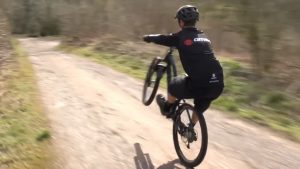
- Первым делом вам необходимо потренироваться отрывать от земли переднее колесо велосипеда. Прочувствовать как при этом работают ваши мышцы и как ведет себя велосипед. Делать это нужно в положении стоя на педалях, выдвигая корпус слегка за седло;
- Когда вы прочувствуете как себя ведет велосипед при этих действиях и поймете, что готовы осмысленно продвигаться дальше, то пробуете повышать сложность и пытаться чуть дольше удерживать переднее колесо в воздухе. При этом уже более уверенно уводить корпус за ось седла к заднему колесу велосипеда;
- При смещении за седло стопы вместе с педалями слегка поворачиваются от горизонтального положения к вертикальному. Это позволит вам дать свободу маневрирования коленями и тазом;
- На этой стадии вам необходимо уяснить, что важно подтягивать нос велосипеда к себе, а не наоборот. То есть вы должны тянуть руль на себя, не сгибая при этом руки в локтях. Если вы будете сгибать руки, пытаясь подтягивать таким способом руль к себе, то будет смещаться центр тяжести, который должен находиться за седлом велосипеда. А при неправильном распределении веса тела, будет крайне сложно хоть какое-то время удержать баланс. Поэтому руль тянем с прямой спиной, на выпрямленных руках, как бы плечами;
- Для того чтобы понять принцип работы мышц и как работает развесовка в момент мануала, можете воспользоваться «стенкой». Став ногами на лестницу конструкции, руками взявшись через 2 – 3 перекладины выше и в таком положении повиснуть на выпрямленных руках. Попробовать подвигать корпусом вверх-вниз, ближе к «стенке» и дальше от нее. В этом положении вы сможете прочувствовать как меняется центр тяжести и в каких точках опор происходят изменения во время смещения корпуса в пространстве;
- Выход в мануал может осуществляться двумя способами – рывком и плавным смещением. Здесь оба способа правильны. Пользоваться можно тем, который вам кажется удобнее.
Плавный способ – присевши (на опущенное седло), на вытянутых руках и с прямой спиной, начинаем постепенно смещать по горизонтальной оси корпус за седло. Смещаем до тех пор, пока не почувствуем точку баланса. После чего начинаем балансировать, смещая корпус ближе или дальше от седла в горизонтальной плоскости.
Рывковый способ – в этом случае мы, как и в банни-хопе, описываем тазом «угол», смещая корпус сначала вертикально вниз до крайнего нижнего положения, а потом сразу назад за седло. Делается это одним заходом, без промедления между смещением вниз и назад, со всеми теми же нюансами по положению рук и спины, как и в плавном способе; - Когда начнет получаться хоть немного удерживаться в мануале, начинайте работать над техникой баланса.
Не выпрямляйте ноги. Согнутые колени позволяют смещать корпус в горизонтальной плоскости. Как только вы выпрямите колени, то, скорее всего, уже не сможете их согнуть, не потеряв баланс.
Не задирайте таз высоко над колесом. Чем ближе ваша «пятая точка» к колесу, тем ниже центр тяжести, а значит и проще удерживать баланс;
- В дальнейшем, по мере того как время удержания велосипеда в мануале будет увеличиваться, можете пробовать добавлять наклонные поверхности.
Серф
При выполнении серфа делаем все тоже самое. С одной лишь разницей – к балансу корпусом добавляется задний тормоз, который выполняет действие, аналогичное смещению корпуса ближе к седлу. То есть если чувствуете, что вас начинает заваливать назад, то легкими нажатиями тормоза вы будете заставлять нос велосипеда опускаться.
Советы
Выведем несколько популярных ошибок, которых нужно избегать для успешного выполнения manual:
- Сгибание рук при выдергивании руля на себя;
- Выход в manual не описывая «угол», а срезая корпусом по диагонали;
- Поднятие таза высоко над колесом;
- Разгибание ног во время балансирования над задним колесом;
- Удерживание стоп в положении горизонтально поверхности земли.
Это частые ошибки учащихся мануалу. Чем скорее вы от них избавитесь, тем скорее тренировки будут приносить положительный эффект.
Как и в любые серьезные трюковые элементы маунтинбайкинга, мануал требует упорных и многодневных тренировок. Необязательно зацикливаться на нем, пробуйте делать трюк во время покатух. Не стоит превращать свое обучение в изнурительные нервные попытки. Важно, чтобы обучение не превратилось в нежеланные мучения. Если конечно manual не способ вашего заработка на жизнь 🙂
Итоги
Мануал можно учить, а можно обойтись и без него. Но если вы любите красиво кататься и приобретать новый опыт владения своим велосипедом, то этот элемент вам обязательно понравится. Пробуйте, тренируйтесь, возьмите советы того как не нужно делать во время выполнения элемента и старайтесь их придерживаться. Со временем, конечно же, у вас все получится. Удачи!
Автор: [Имя автора]
Введение
Мануал в BMX является одним из основных трюков, который выполняется на BMX Pipe 1.9.9. Мануал — это трюк, который представляет собой балансировку на заднем колесе, при которой переднее колесо должно быть приподнято от земли. В данном гайде мы рассмотрим подробные шаги и техники, которые помогут вам выполнить мануал на BMX Pipe 1.9.9.
Шаги выполения
Шаг 1: Начальная позиция
- Подготовьте свой BMX Pipe 1.9.9 и убедитесь, что он находится в хорошем состоянии.
- Встаньте на педали BMX с ногами на подходящем для вас расстоянии.
- Разгрузите переднюю сторону велосипеда, наклонив на небольшой угол назад.
Шаг 2: Взлет
- При помощи рук и верхней части тела, отклоните переднюю часть BMX вверх, при этом поднимая переднее колесо от земли.
- Раскачивайте велосипед вперед-назад для создания дополнительного баланса.
- Оставайтесь фокусированными и удерживайте стабильность на заднем колесе.
Шаг 3: Балансировка
- Когда вы добьетесь достаточной высоты и устойчивости, начните балансировать на заднем колесе.
- Отклоняйте свое тело в нужном направлении, чтобы сохранить равновесие и предотвратить падение.
- Контролируйте баланс с помощью рук и шарниров тела, чтобы сохранить стабильность в мануале.
Шаг 4: Завершение мануала
- Продолжайте балансировать на заднем колесе и двигаться вперед или выполнять вращательные движения, если это нужно для вашего трюка.
- Приближайтесь к окончанию мануала плавно и контролируемо.
- Опустите переднее колесо на землю, когда вы решили закончить выполнение мануала.
Советы и предостережения
- Начните с выполнения мануалов на ровной поверхности, прежде чем переходить к более сложным условиям.
- Обязательно носите защитный шлем и экипировку для BMX при выполнении трюков, чтобы предотвратить возможные травмы.
- Проконсультируйтесь с опытными райдерами и тренерами BMX для получения дополнительных советов и инструкций.
Заключение
Выполнение мануала на BMX Pipe 1.9.9 требует технического мастерства и навыков балансировки. Следуя подробному гайду и практикуясь на регулярной основе, вы сможете улучшить свои навыки и достичь успеха в этом трюке. Однако, помните о важности безопасности и быстрой реакции во время выполнения мануала на BMX. Удачи!
Do you want to learn how to manual on a BMX bike?
The manual is a foundational BMX trick that involves balancing on the rear wheel while coasting.
Note: A wheelie is when you balance on your rear wheel while pedaling. But when doing a manual, you also balance on the rear wheel just without pedaling.
Today, we’ll dive deep into the art of manualing on a BMX bike, a fundamental skill that’s as cool as it is practical.
Friendly Reminder: Save BIG On Dan’s Comp! (Click Banner)
Manuals are not just about showing off; they’re crucial for navigating through trails, pump tracks, and city streets, allowing you to tackle obstacles with style and finesse.
So, if you’ve been itching to perfect your manual and showcase your skills at the local park, you’re in the right place.
Grab your helmet, pump up those tires, and let’s roll into the journey of mastering the manual on your BMX bike together! 🤘
You may also be interested in my collection of beginner BMX tricks. Master the basics!
Why Manual?
Learning to manual on a BMX bike is like acquiring the keys to a whole new world of biking experiences and skills.
Here’s why learning a manual is essential for any BMX rider:
1. Foundation For Advanced Tricks
Manuals are foundational skills, and once you’ve got them down, they serve as stepping stones to more advanced BMX tricks like nose manuals, bunny hops, and jumps.
Not just that, but manuals are perfect for linking tricks together in EPIC lines!
2. Enhanced Balance & Control
Mastering the manual requires maintaining balance on the rear wheel while modulating the bike’s balance using your body weight.
This significantly improves your overall balance and bike control, crucial for performing other BMX tricks and general riding.
3. Better Flow
Knowing how to manual can help you smoothly navigate over obstacles, allowing you to maintain speed and flow without having to pedal as much.
4. Increased Style Quotient
Let’s face it, pulling off a manual effortlessly adds a dash of style and flair to your ride.
It looks cool and is sure to turn heads whether you are at the park, street, or dirt jumps.
So basic but always does the – well – trick.
5. Efficient Use Of Momentum
Manuals teach you how to use your momentum effectively, allowing you to carry speed over sections of the trail or park without pedaling, making your rides more efficient and fluid.
6. Boosted Confidence
Achieving a manual significantly boosts your confidence, encouraging you to try and master more challenging tricks and maneuvers, pushing your BMX riding to new heights.
7. Enhanced Spatial Awareness
Performing a manual requires an acute awareness of your body and bike positioning.
This enhanced spatial awareness is vital for executing other BMX tricks and avoiding accidents.
8. Fun Factor
Lastly, manuals are downright fun!
There’s a unique joy in riding on one wheel that you only understand after you master manuals.
Learning to manual on a BMX bike opens up a realm of possibilities, enriching your riding experience with new skills, better control, and more enjoyment.
Sadly, I still see many riders who want to skip manuals and go straight to advanced tricks. Unfortunately, this shows in their riding style, skills and overall bike control.
Don’t try to take shortcuts.
Learn how to manual. Trust me, you’ll thank yourself later.
How To Manual BMX For Beginners
Safety First:
Even though a manual is a basic trick, you can still slam pretty hard.
You can loop out and if you don’t catch yourself with your legs, you go straight to the head.
Thus:
- Wear your safety gear: helmet, knee pads, shin pads and elbow pads.
- Ensure your BMX bike is in good condition (check my BMX bike maintenance guide), with properly inflated tires and functioning brakes. (I recommend you learn manuals with brakes first before going brakeless.)
Find a Suitable Location:
Look for a smooth, flat surface free from traffic and obstacles. A parking lot or an empty road are good places to start.
Or in my example (see the video above), an empty basketball court is also a great place to start.
Steps-By-Step Guide
1. Ride At A Moderate Speed
Start by riding your BMX at a comfortable, moderate speed. You don’t want to go too fast or too slow.
I actually suggest you go slower than faster. Because if you master slow manuals, faster will be even easier.
2. Body Position
Position your body centrally over the bike, with your knees and elbows slightly bent.
3. Crouch Down
Lower your upper body towards the handlebars, as this will make it easier to shift your weight backward.
4. Shift Weight & Lift
Shift your weight to the back of the bike while pulling up on the handlebar.
Use your arms, not just your wrists. The aim is to lift the front wheel off the ground.
If you’ve never lifted your front wheel, stay at this stage for a while before moving forward.
Even starting at lifting your bike for 1-2 inches is enough. Get comfortable before you fully commit.
5. Find the Balance Point
The trickiest part of the manual is finding the balance point where you can coast on the rear wheel.
If you go too far back, you risk falling backward; if you don’t lean back enough, the front wheel will drop back to the ground.
Pro tip: I actually advise everyone that you get comfortable “falling backward.”
You don’t necessarily need to fall to the ground, just learn how to catch yourself with either one of your legs or both.
6. Legs and Hips for Balance
Use your legs and hips to maintain balance.
If the front wheel starts dropping, lean back slightly (you can also pull your handlebar closer to your body).
And if you feel like you’re tipping backward, shift your weight forward slightly.
7. Use Your Knees
Keep your knees bent and flexible so you can quickly adjust your balance.
8. Keep Your Eyes Forward
Look ahead, not down at the front wheel. This helps you maintain a sense of balance and direction.
9. Control With Rear Brake
If you feel you’re leaning too far back and losing control, gently tap the rear brake to bring the front wheel back down.
This is a safety measure and it’s good to practice this.
That’s why I recommend you learn manuals with brakes before removing them.
10. Exit Safely
To exit the manual, simply shift your weight forward and allow the front wheel to come back down to the ground.
And if you’re dropping off of a curb, try to land both wheels simultaneously or slightly rear-wheel first.
Practice
The manual takes a lot of practice to master. That’s the brutal truth.
Start with short distances and aim to extend the length as you get more comfortable.
Video analysis can be useful. Record your attempts and review to see what you could do better.
Pro tip: Before you start manualing ledges and curbs, I recommend jumping in and out of a manual on the flat first. I demonstrate this in the video above.
Once you’re comfortable with the manual, you can incorporate it into other tricks and techniques.
One of my favorites is a manual 180.
What Are Some Of The Mistakes When Learning A Manual
When learning to manual on a BMX bike, beginners often encounter several common mistakes.
Avoiding these will help accelerate your learning curve and prevent unnecessary falls or injuries.
Here are some common mistakes and how to avoid them:
1. Leaning Too Far Back
- Mistake: Many beginners tend to lean too far back, causing the bike to slip out from underneath them.
- Solution: Focus on finding the balance point by shifting your weight gradually. Practice over a grassy or soft surface to minimize the impact of potential falls.
2. Locking the Arms Too Soon
- Mistake: Locking your arms straight as soon as you start the manual can limit your control over the bike.
- Solution: Keep a slight bend in your arms as you initiate the manual, allowing for adjustments as you find your balance.
3. Incorrect Body Position
- Mistake: Positioning the body too high above the bike can make balancing difficult.
- Solution: Maintain a low center of gravity by keeping your body closer to the bike, allowing for better control and stability.
4. Using Too Much Force
- Mistake: Some beginners tend to yank the handlebars too hard, leading to overbalancing.
- Solution: Use a gentle, controlled pull to lift the front wheel and focus on using your weight shift to maintain the balance.
5. Lack of Rear Brake Control
- Mistake: Neglecting to use the rear brake can result in tipping over backward.
- Solution: Learn to feather the rear brake gently to bring the front wheel down and prevent falling backward.
6. Ignoring Core Engagement
- Mistake: Not engaging the core muscles can make it difficult to maintain balance during a manual.
- Solution: Keep your core engaged to stabilize your body and have better control over the bike.
But more than focusing on the core, focus on finding the balance point, you’re core will work and adjust automatically.
7. Inconsistent Practice
- Mistake: Practicing irregularly or infrequently can hinder progress.
- Solution: Regular, consistent practice is key. Dedicate time each day or several times a week to practice manuals. In short, the more, the better.
8. Not Looking Ahead
- Mistake: Looking down at the front wheel or feet can disrupt balance and alignment.
- Solution: Keep your gaze fixed on a point ahead of you to maintain balance and direction.
9. Impatience and Frustration
- Mistake: Giving up too soon due to frustration or expecting to master manuals quickly.
- Solution: Be patient, stay positive, and understand that learning to manual takes time and consistent effort.
10. Ignoring Safety Gear
- Mistake: Not wearing appropriate protective gear can result in injuries.
- Solution: Always wear a helmet, shin pads, knee pads, and elbow pads to protect yourself while practicing. Gloves are helpful for some, too.
Final Advice:
Remember, every rider has a unique learning curve, so don’t be discouraged by initial challenges.
Celebrate small victories, keep refining your technique, and most importantly, have fun on the journey to mastering manuals.
I also listed common beginner BMX mistakes and how to avoid them.
Conclusion: Master Manuals!
It’s been a thrilling ride exploring the ins and outs of mastering manuals.
We’ve delved into the whys and the hows and discussed the common pitfalls we might stumble upon in our learning journeys.
Remember, the path to mastering a manual is paved with persistence, patience, and heaps of practice.
Now, it’s over to you, my fellow BMX dudes!
Equip yourselves with your protective gear, hit your local spots, and start practicing those manuals.
Take it slow, stay safe, and don’t forget to enjoy every moment on your bike.
Embrace the falls and the wobbles, and celebrate the small wins — they’re all part of the beautiful journey of BMX riding.
Was this article helpful?
Yes!No
Friendly Reminder: Save BIG On Dan’s Comp! (Click Banner)
Disclosure: The BMX Dude’s content is free & reader-supported. I may earn a commission if you click & buy through my links. Your support helps me create the best content & make a difference. Thanks! 🤘
Want to learn how to manual on a BMX bike?
If you’re just starting out in BMX, there’s a good chance you’re trying to learn how to manual on a BMX bike, and you’re finding that it’s trickier than it seems when you first start trying to figure the trick out. Dustin Lee decided to whip up a how to video showing you how to learn the trick from just getting it started to holding it longer and applying it to a few different spots like hopping up onto a ledge. This is one of those tricks that start out super difficult, but once you get a lot of practice and figure it out, it becomes easier and easier and you can quickly learn how to add it to lines, mix tricks before or after the manual and more. So, if you’re looking to learn how to manual on a BMX bike, then you’ll want to get on that play button and take it all in, then grab your bike and get to work on it!
“Welcome back to another video. I recently met some kids who were asking about tips on how to manual, so I figured why not make a video? So here you go, I hope you enjoy and if you have any follow up questions, please comment on the video.” – Dustin Lee
What do you think of the video? Did it help you figure it out? Do you have any personal tips or tricks that Dustin didn’t mention that helped you learn this trick? Let us know what is on your mind in the comments down below! It’s pretty cool how little tips can help somebody completely figure out a trick they might be struggling on, and this is one of those tricks that small adjustments can make a huge difference!
Gearbikesreview is audience-supported. When you buy through links on this site, we may earn an affiliate commission that we use for site maintenance. Learn more
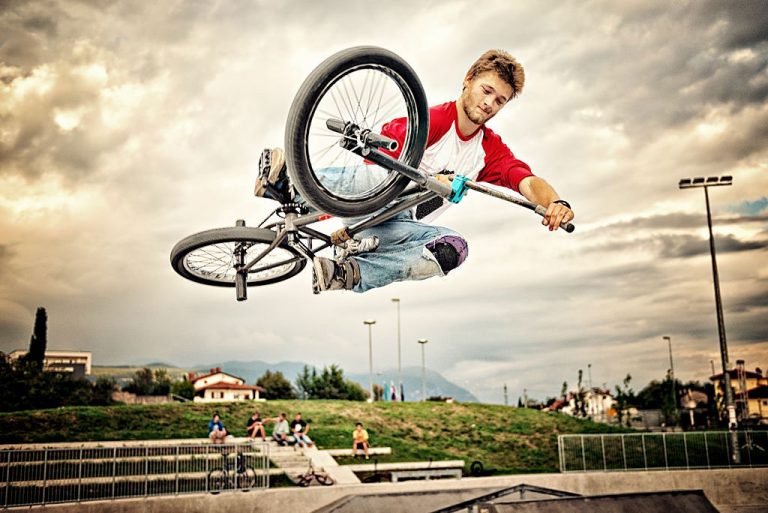
The first question that pops into one’s mind is what on earth BMX is! Well, its bike motocross. A BMX bike is an off-road sport bicycle used for racing and stunt riding. Scot Alexander Breithaupt is credited as the founding father of BMX in 1970, where else but Long Beach, California. He was a mere stripling of 13 years when he started off in BMX. Soon kids took to country dirt tracks racing and trying out stunts. It grew steadily in popularity. BMX riding is inherently dangerous. Here we will take you through how to manual BMX.
What Is a Manual?
A likely definition of a manual is riding and balancing on the rear wheel without any motion of the pedals. But why call it a ‘manual’. On a bike, a wheelie is gaining speed before lifting off the front wheel. A manual, on the other hand, relies on physically using your arms to lift up the front wheel off the ground, hence manual as some sources suggest. Because of its long wheelbase, BMX bikes are extended. A manual is all about balance and shifting body weight. BMX bikes do not have suspension. So riders rely on maximum power and thrust to overcome obstacles on the sprint around a race track. The legs and bodies absorb impacts.
A manual is basically riding on the rear wheel without pedaling. You simply haul the front wheel off the ground and shifting your bodyweight back, balance with the legs.
- The manual is pretty much the first step in getting into the bunny hop. Finding the balance point and holding it is the trick.
- To learn to manual, the rider has to bear in mind that factors to take into account are body weight, the length of the bike, and their center of gravity to find the balance point.
- A manual is the basis of many beginner bmx tricks.
Learning to Manual on a Flat Surface
1. Getting Into the Manual
You want to be certain that the pedals are right below the balls of your feet, with the feet pointing faultlessly forward. Ensure the handlebar is set parallel to the fork. Keep your index finger on standby over the brake lever in readiness to be deployed in the event of starting to wheelie out.
As pointed out earlier, to enter into the manual, three actions should be performed; the front wheel has to be lifted off the ground, your weight shifts back so that your center of gravity is above the wheel.
This is not be confused with a BMX flatland which is essentially a freestyle technique done on smooth, flat surfaces.
2. The Dos and Don’ts
Dos
- Be cool.
- Ensure pedals positioned below balls of feet.
- At a little more speed than jogging, approach the curb.
- Pedals should be kept level all the time.
- When hoiking the front wheel, keep your arms nearly straight. You’re going to lift the front wheel with your back, not your arms.
- Shift your weight back and at the same time in a smooth motion lift up on the bar.
- Effortlessly, slide your weight behind the seat.
- If you start wheeling too much, your front wheel is too high. Tap your rear brake and this will bring the front wheel down a bit.
- Switch clipped pedals for flat ones. You don’t want your feet clipped in as you practice this.
Don’ts
- Don’t call quits. Keep trying
- Place the middle of the foot on the pedal
- Yank on the bar. Doing it smoothly is the key.
- Lean forward.
- Lift the front wheel with your arms
- Try this with clips unless you have mastered it on flats.
- Don’t break any of the bicycle rules and regulations.
3. Looping Out
This is an abandon maneuver when you have essentially lost control. It happens with everyone and it is better to stay one step ahead and learn how to do it smoothly. Go a grassy patch to be on the safe side.
Yank up on the bar and simultaneously lean back so far that the front wheel keeps lifting. As it goes up you slide backward off the bike. Land on your feet preferably and don’t let go of the bar.
Taking It to the Track
1. The Most Common Mistake
So now that you have had a feel of what it’s like to manual on flat ground, our next stop is the track. This is a completely different ball game. An essential skill here is pumping the rhythm.
Pumping the rhythm is to unweight the bike on the uphill section of the rollers and weight it on the downslope.
This is the first common mistake. Most beginners end up trying the reverse.
2. Do Not Weight the Back Wheel
The rear wheel should only be weighted after crossing the crest. By leaning back up the slope, you are weighting the rear wheel. Big mistake.
The Secrets to Manualing on a Track
What is most desirable when manualing on a track is that the front wheel should dip slightly. This is achieved not by shifting the center of gravity but by pumping the legs hard. This will result in the front wheel rising. If the wheel closes to the ground, force it up by pumping again.
Tips to Do a Perfect Manual
Proper form is what you need to get correct.
- Keep the arms straight. You can flex them a bit but if you want to really do a long manual, keep the arms straight.
- Crouch and get your behind way back till it’s above the rear axle.
- The lower you are, the more stable it is.
- Learn how to jump off the bike and banish the fear of looping out.
- To go long, you need to pump intermittently to hold the balance and keep going.
- Don’t over-focus on the front wheel. It can throw you off track.
- If the front wheel is too high, stand up and straighten out.
- If the front wheel is too low, you get low.
As I mentioned earlier, doing a manual, leave alone a 180 BMX or 360 BMX, is fraught with the element of bodily harm. Do not forget to always have a helmet on, knee and shin pads. In this guide, we have concentrated on the manual mostly as it is the leaping stone for many BMX bike tricks. If you are considering taking up BMX bike riding, it is highly recommended to choose a BMX bike wisely and watch the vast collection of instructional videos out there on the net and do as much reading as you can. Best of luck in your new endeavor.
You may also like
About the author
James Jordan
As a kid I inherited the love for mountain bikes from my father who used to ride for weeks through the Colorado trail in the city of Denver. He had his gang, and I followed pretty much the same track.
Later on, my interest in biking grew more after joining the Enduro race back in 2013. My buddies and I also participated in the Downhill racing for the third consecutive year, and it’s been an amazing experience.

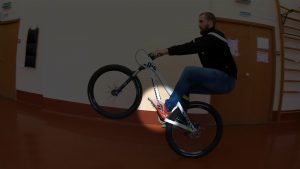
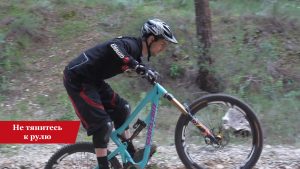

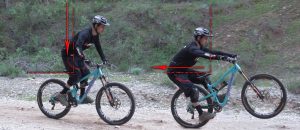
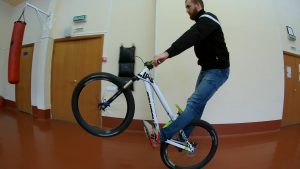 Не задирайте таз высоко над колесом. Чем ближе ваша «пятая точка» к колесу, тем ниже центр тяжести, а значит и проще удерживать баланс;
Не задирайте таз высоко над колесом. Чем ближе ваша «пятая точка» к колесу, тем ниже центр тяжести, а значит и проще удерживать баланс;




